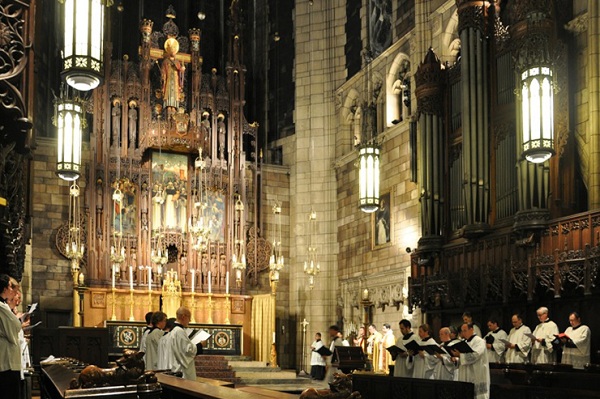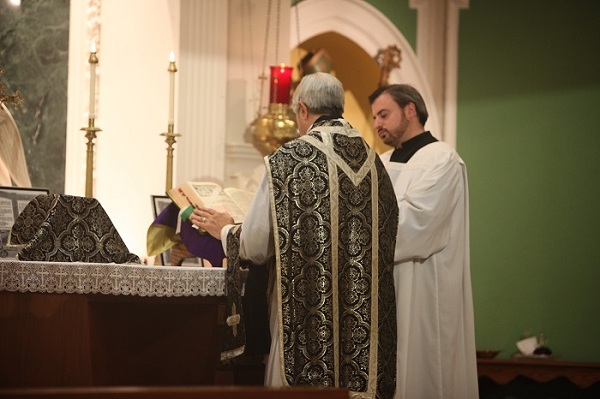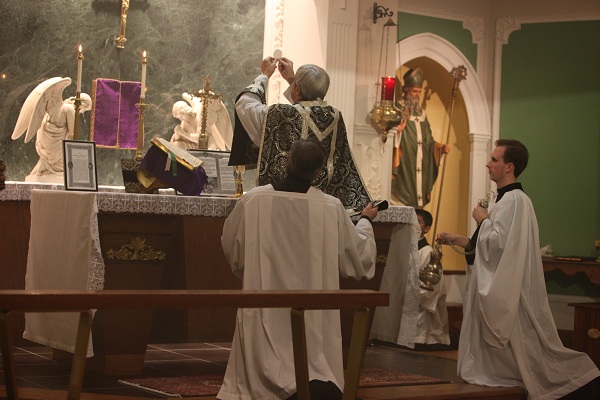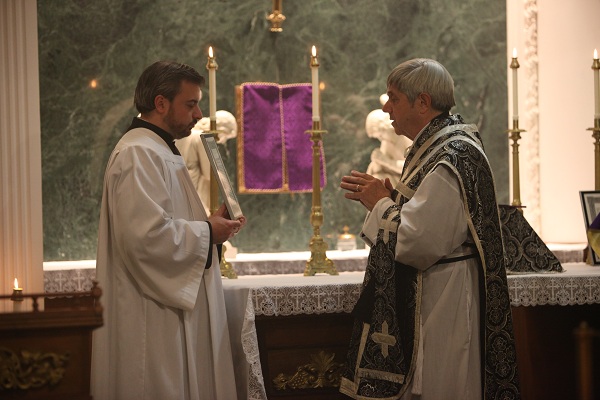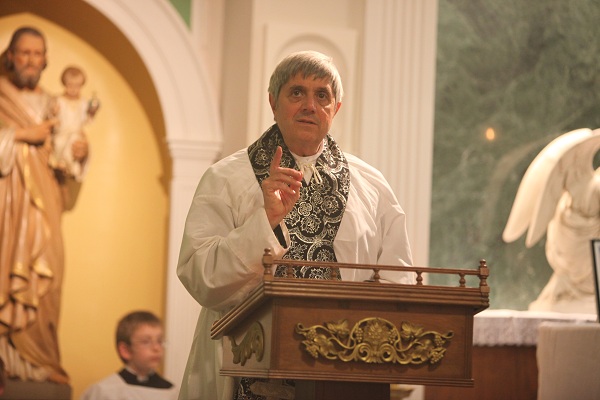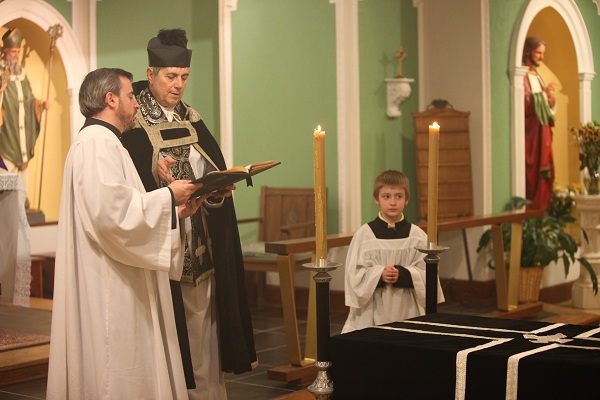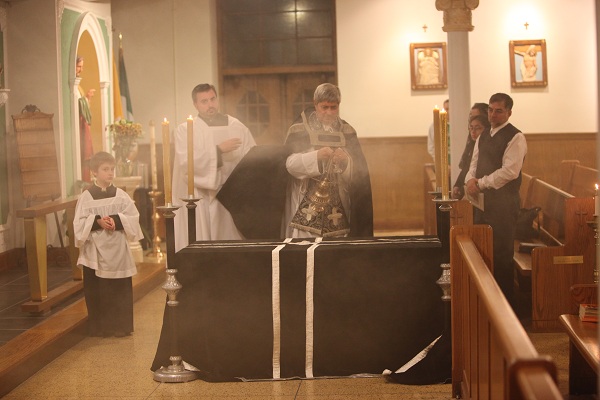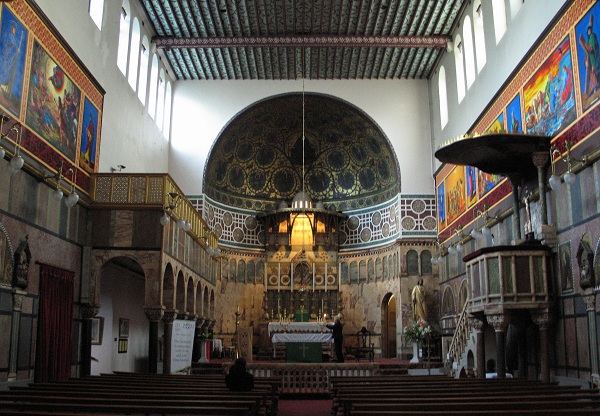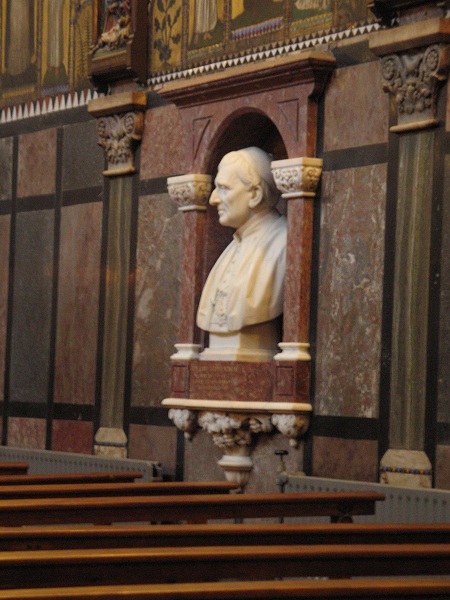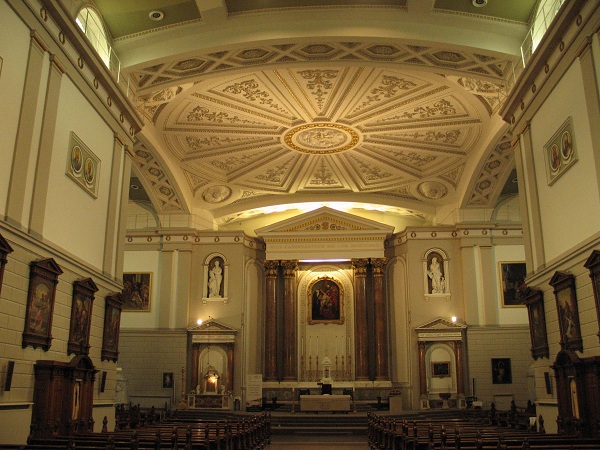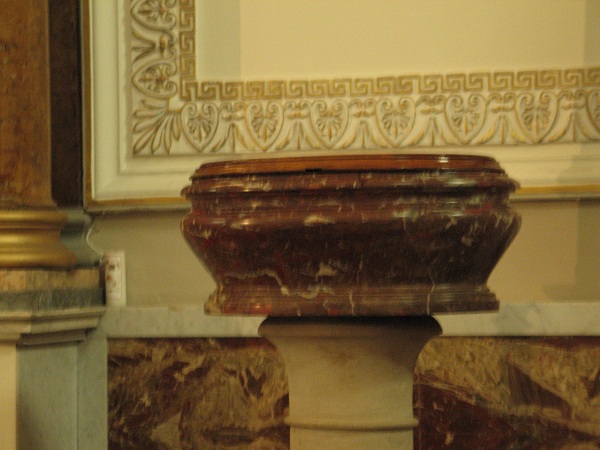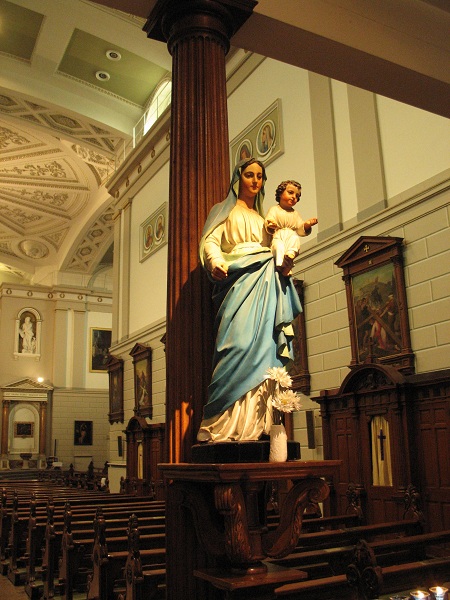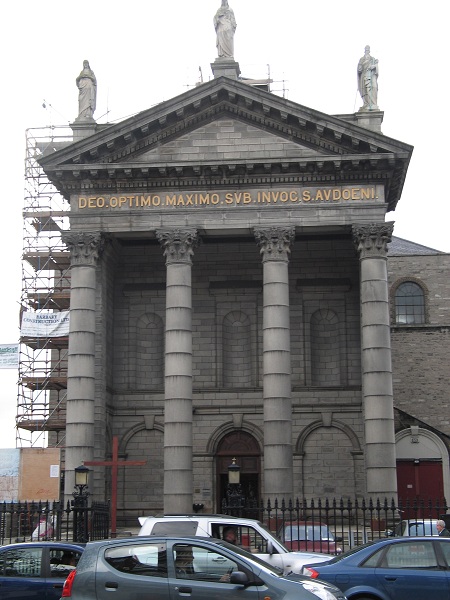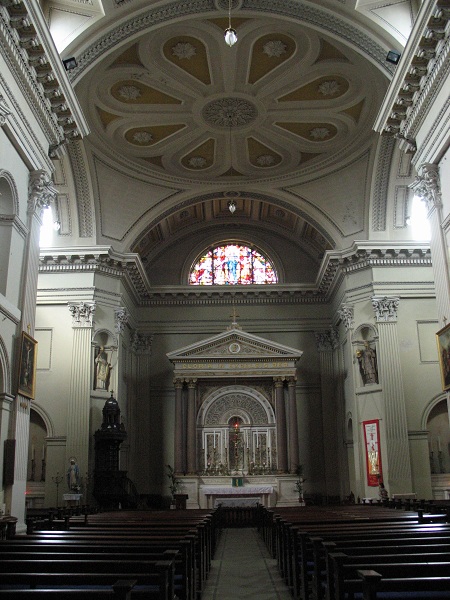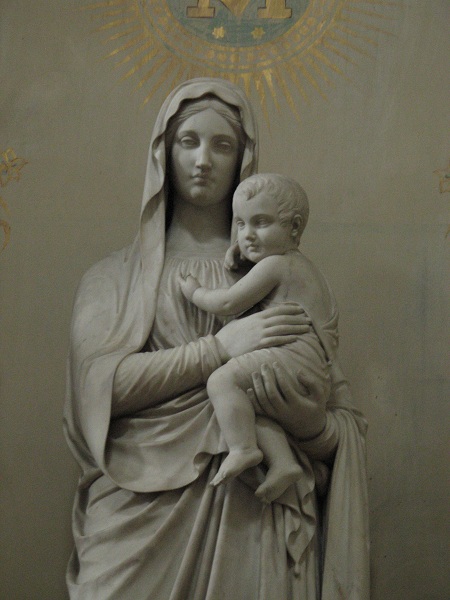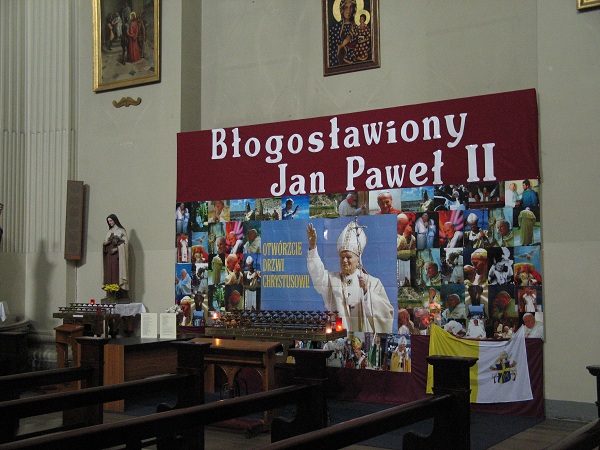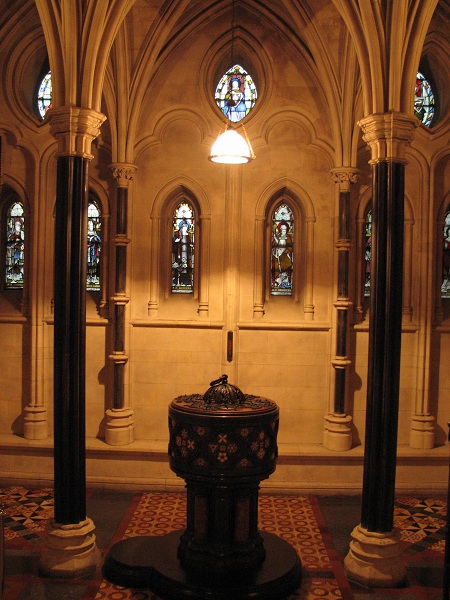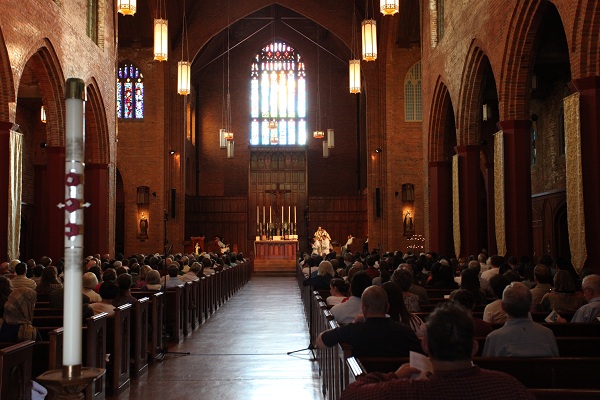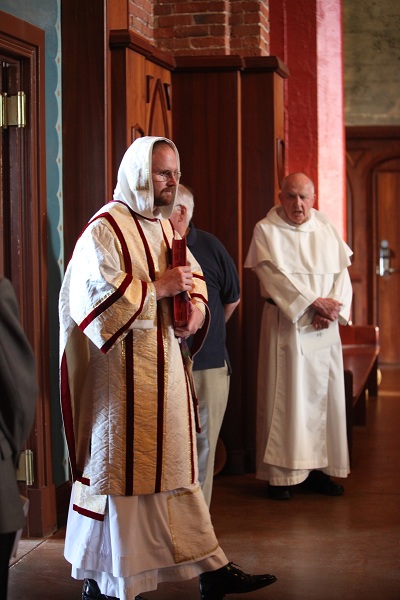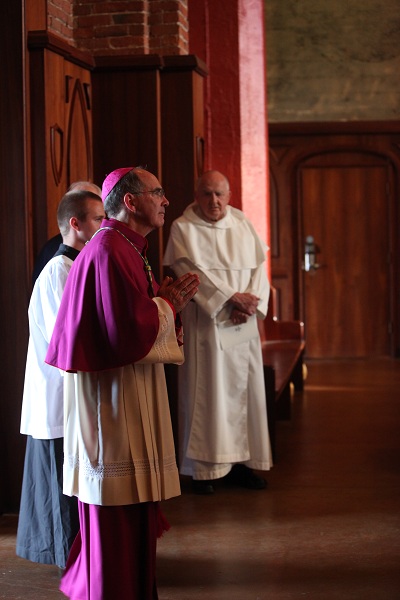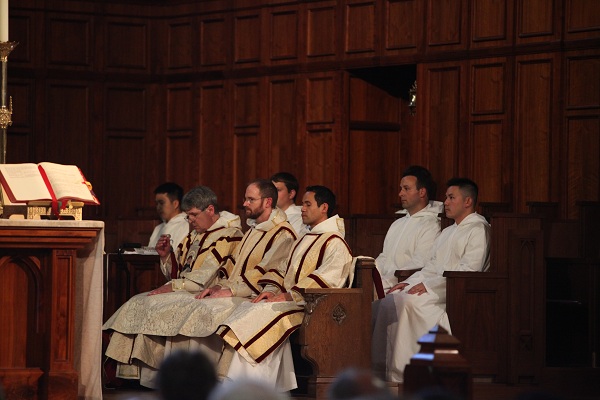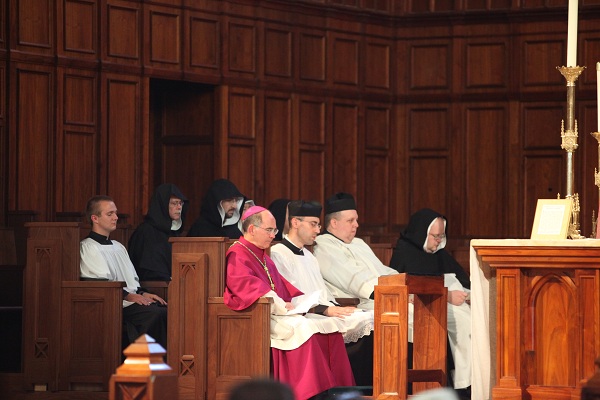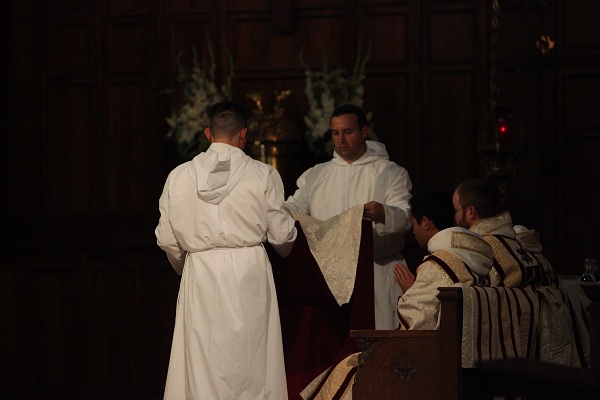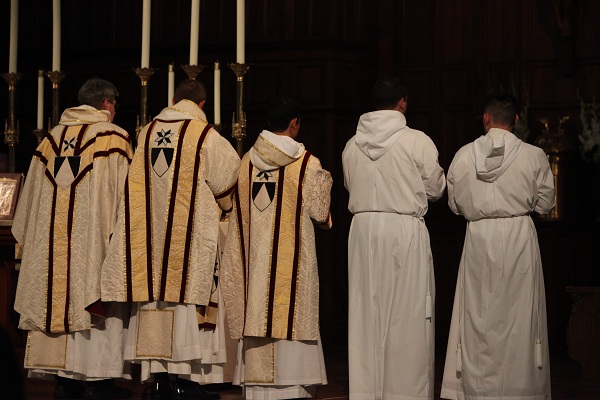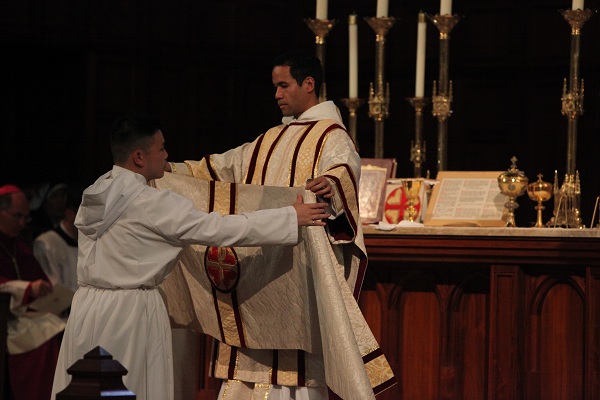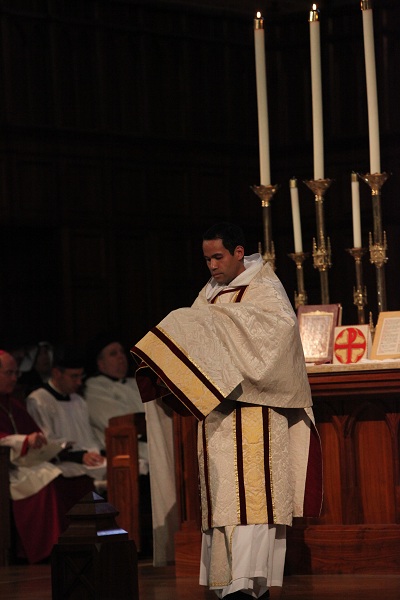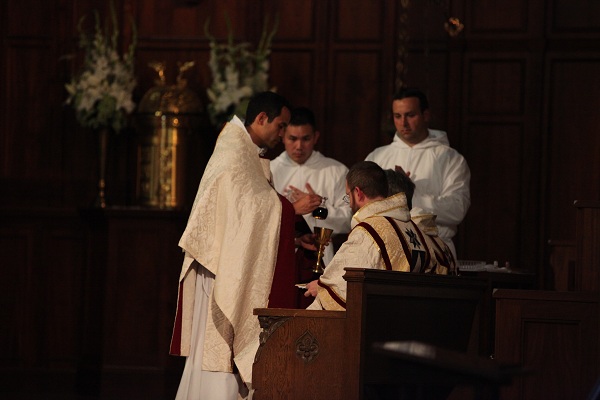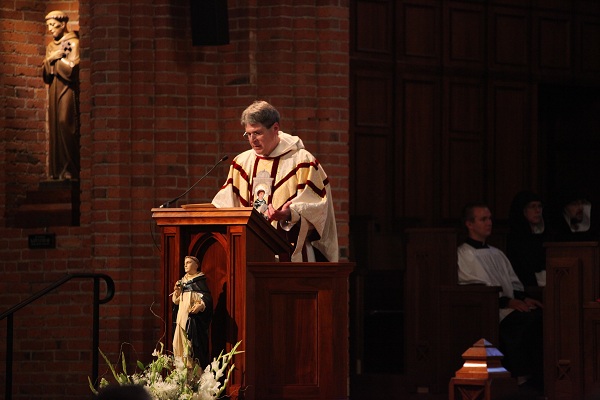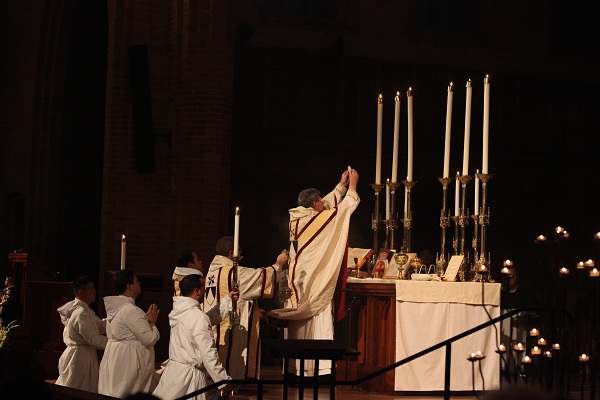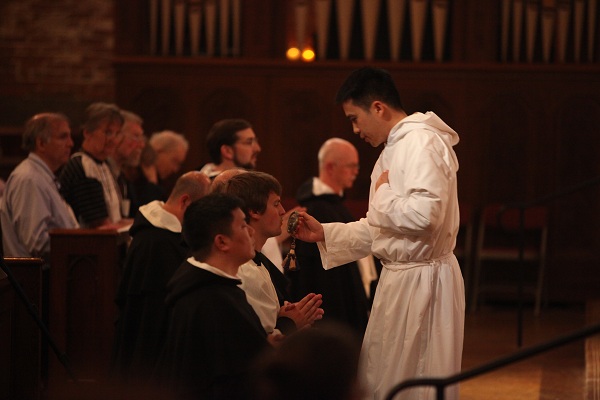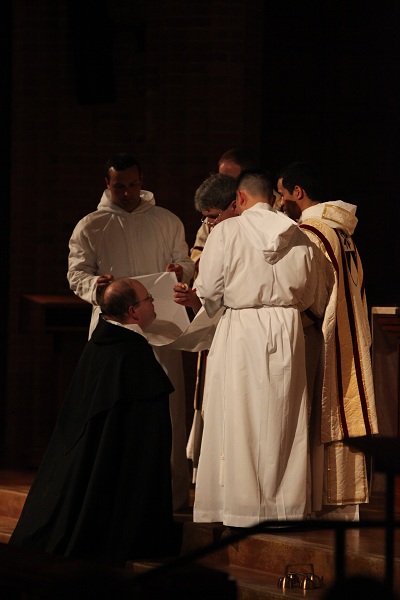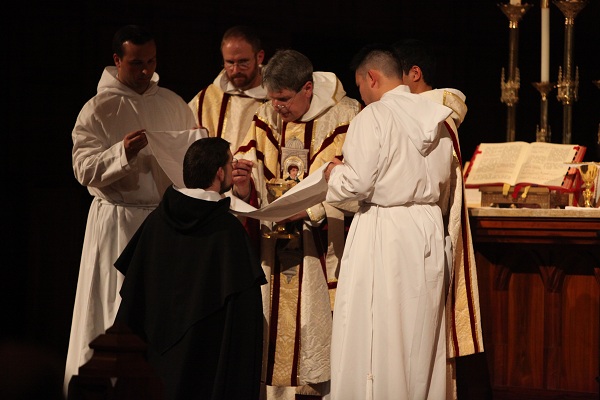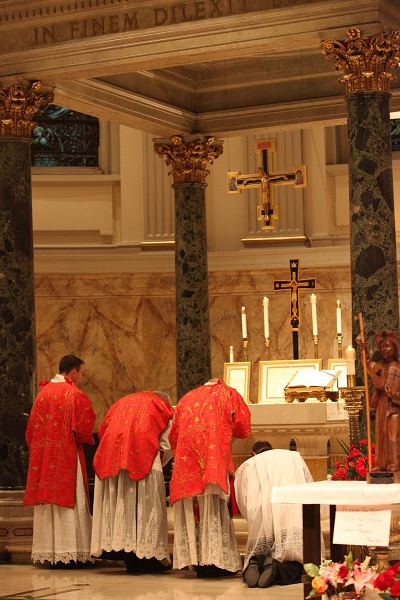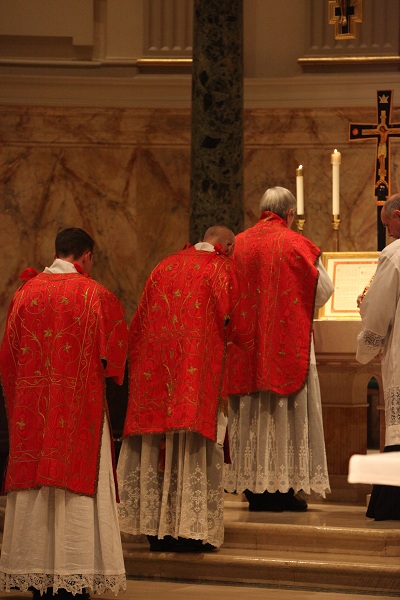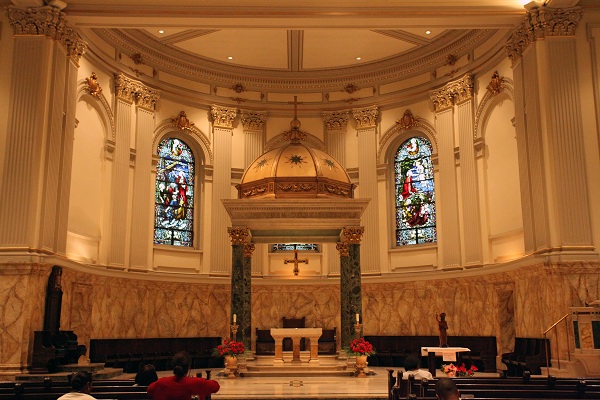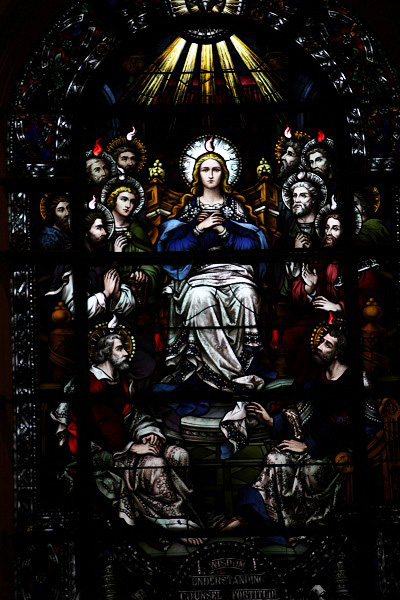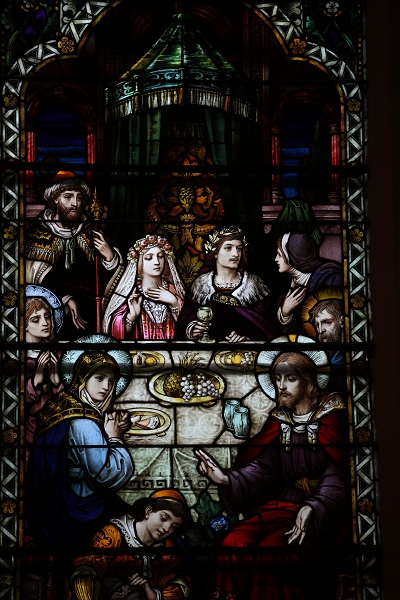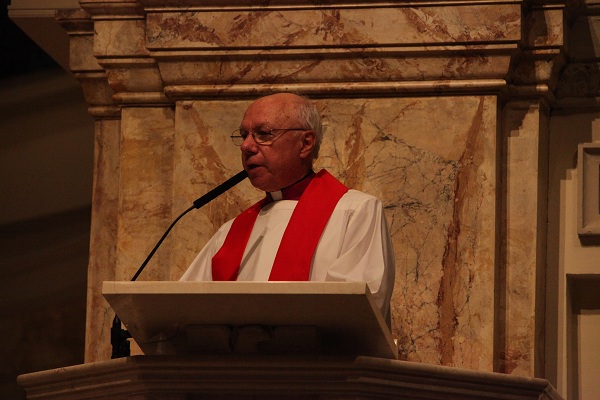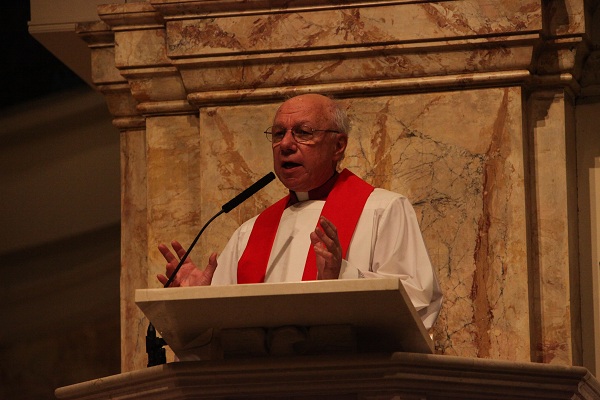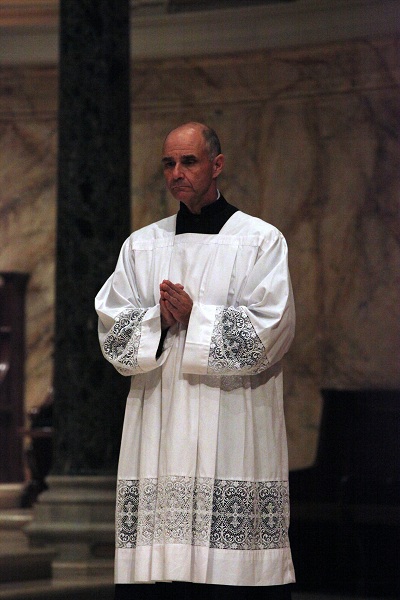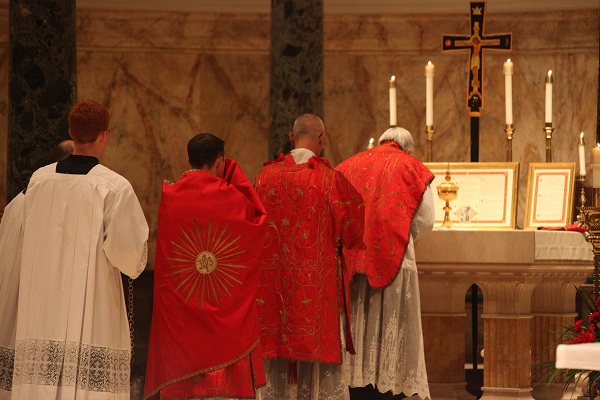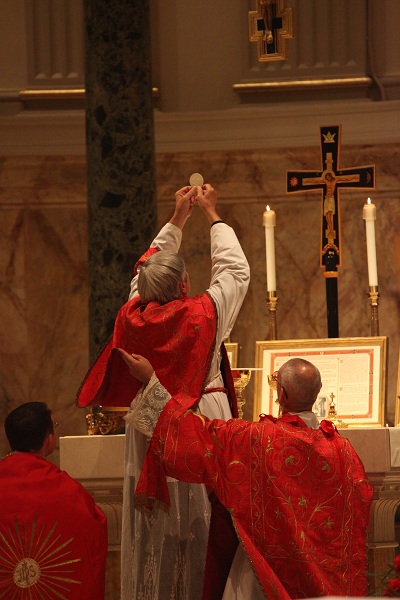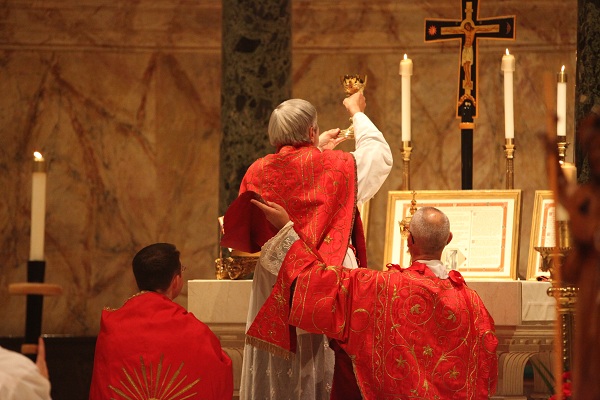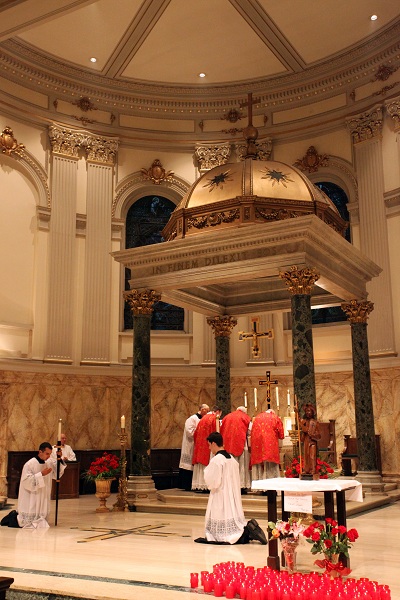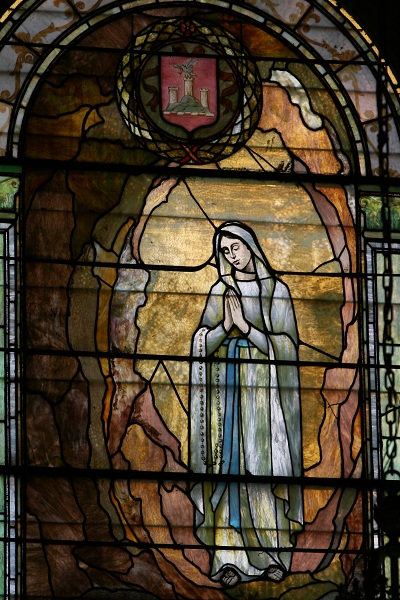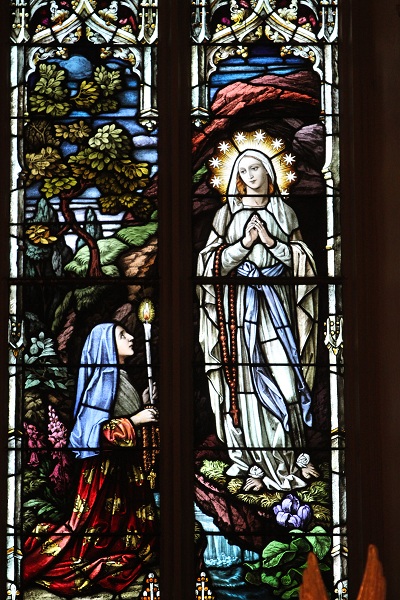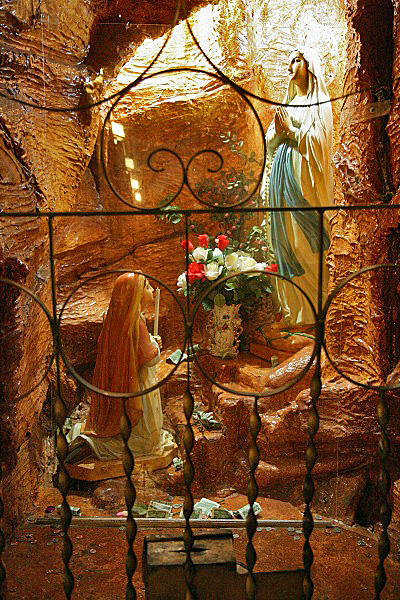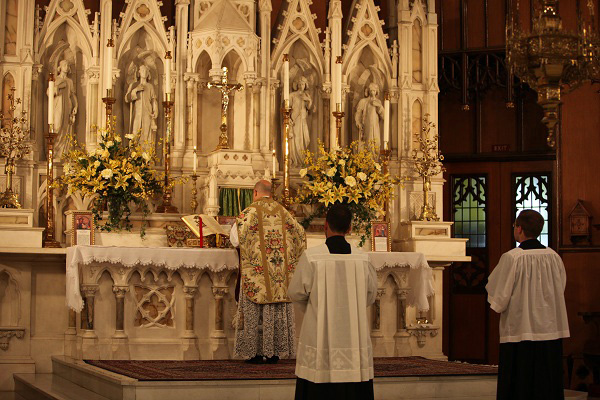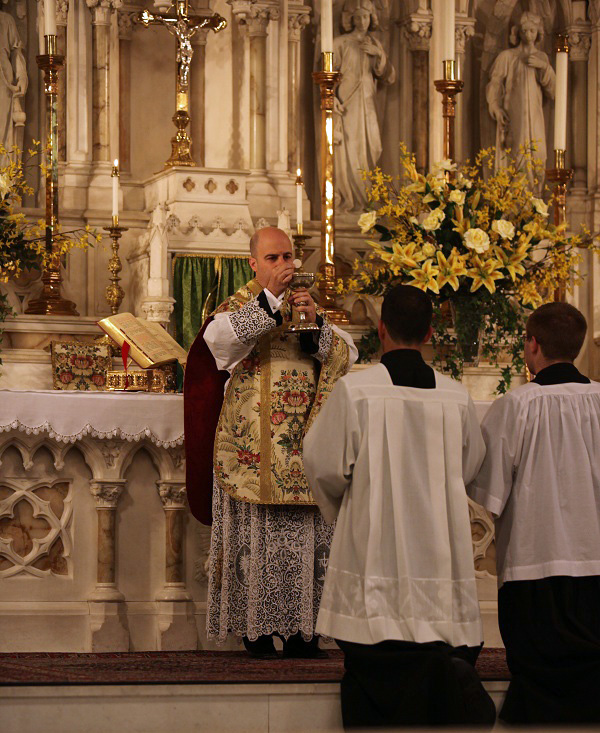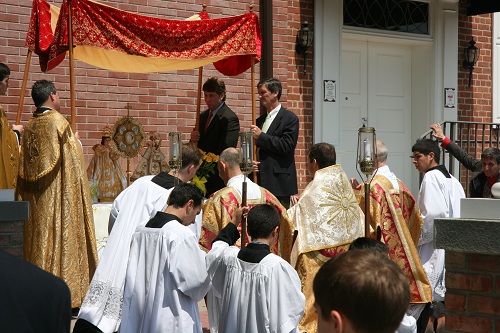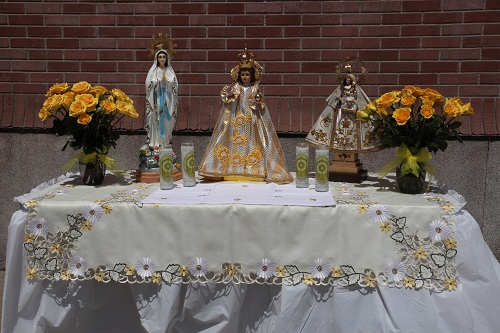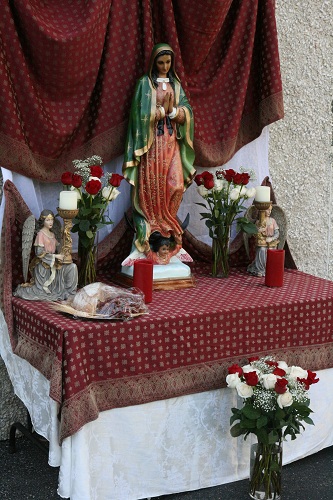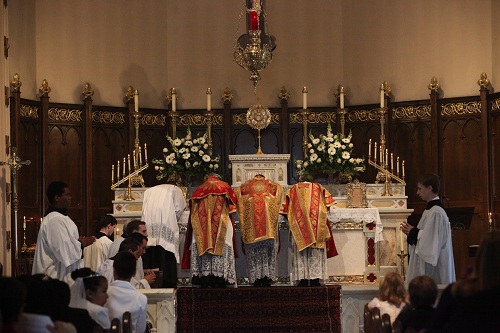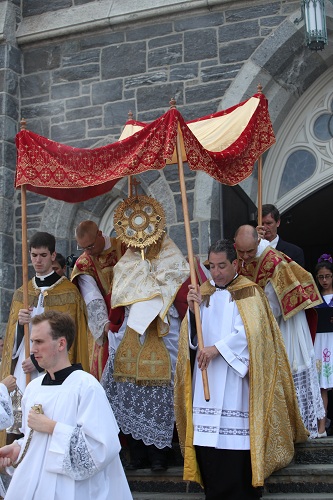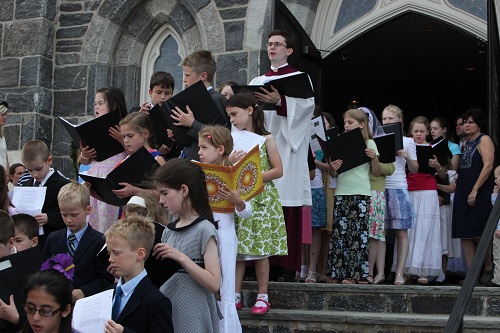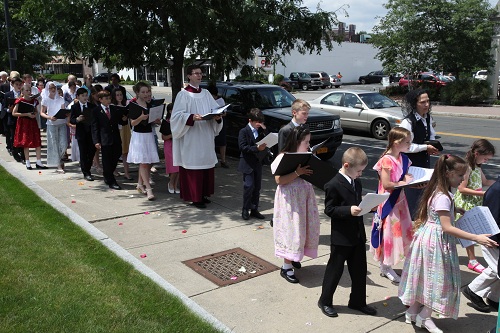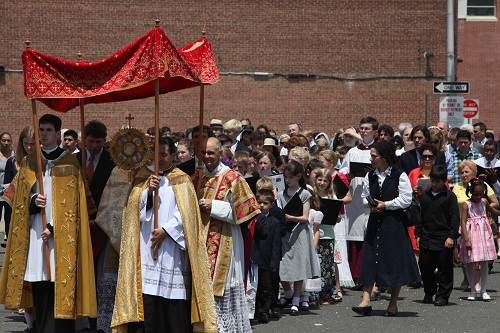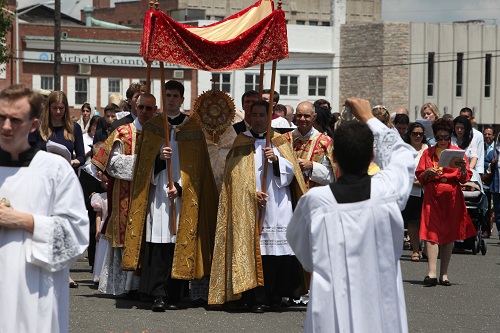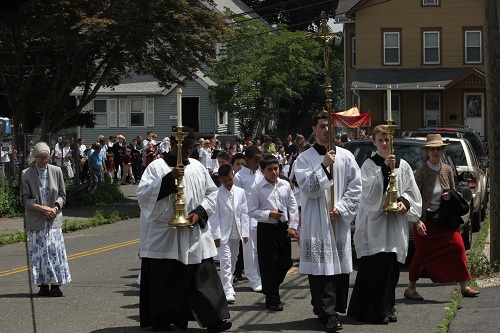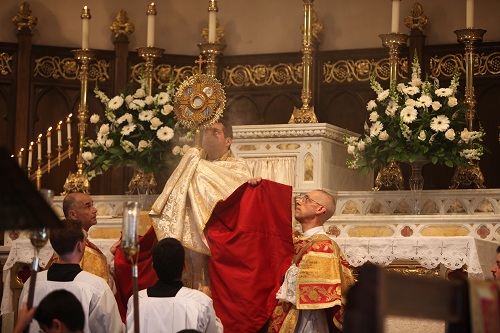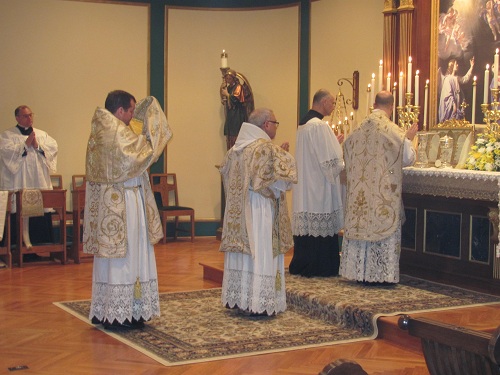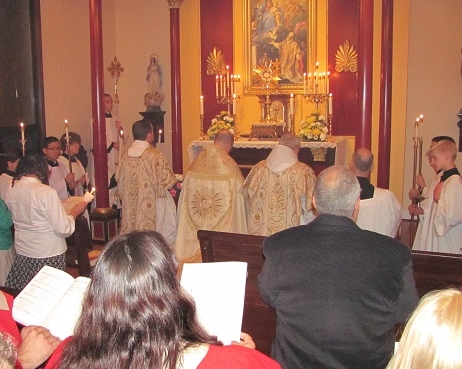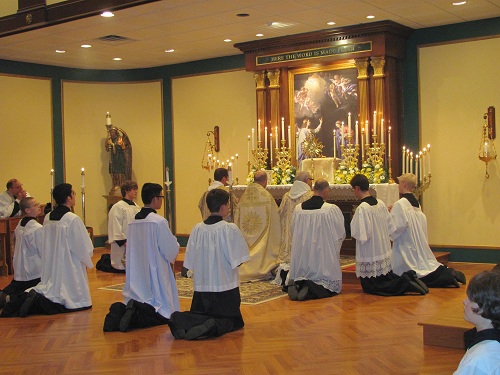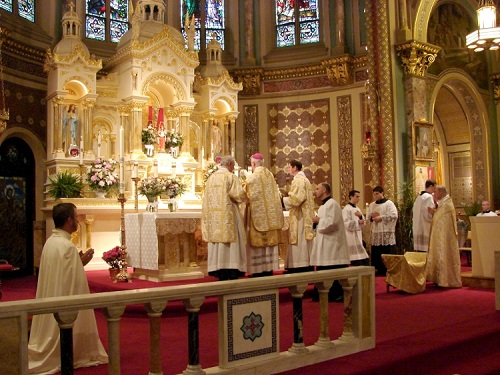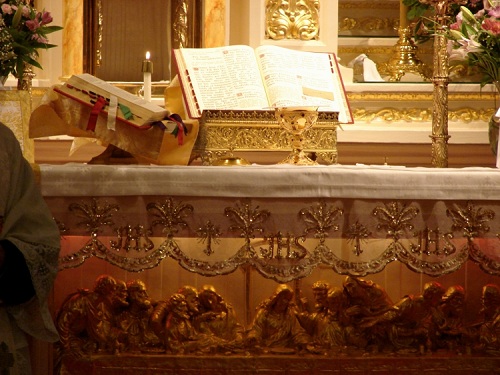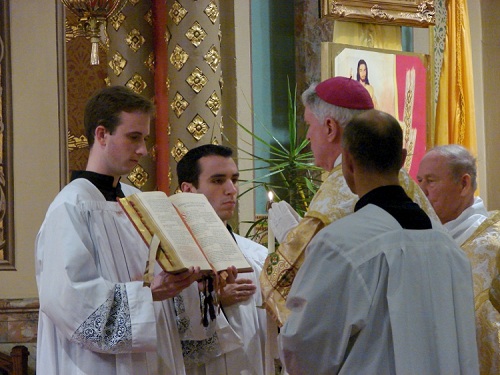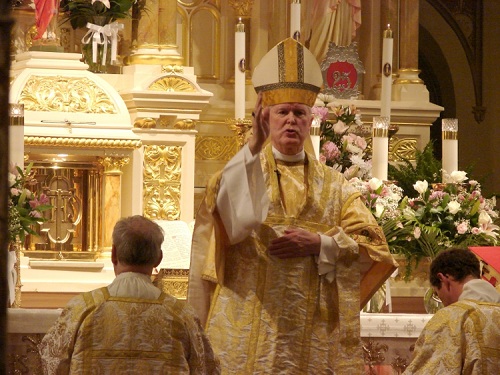8 Nov
2011
2 Nov
2011
All Souls Day at St. Mary’s Church Norwalk
Posted by Stuart Chessman Published in Photos, UncategorizedThe Mass for the Commemoration of the Faithful Departed was held in the chapel of St. Mary’s Church as the church upstairs is being painted. The music for the Mass performed by the St Mary Schola Cantorum was Missa pro defunctis by Antoine Brumel (c.1460-c.1512) and the “Domine Jesu Christe” by Johannes Ockeghem, (c.1410-1497)
20 Oct
2011
Newman’s University Church, Dublin.
What could be of greater interest to the student of the New York Archdiocese than the Church of Dublin? After all, up to the not too distant past the core of the Catholic population in our area was Irish American – and since the early 19th century all the Archbishops have been Irish as well. The true builders of the Archdiocese were indeed the Irish. Why, up till not too long ago there always seemed to be at least one priest at St. Patrick’s Cathedral with a thick brogue – kept on for local color, I guess.
Alas, the visitor quickly discovers that the traditional Ireland of even 20 years ago is no more. A crowd of every nationality and race under heaven pushes through the pedestrian zone of Grafton Street, accompanied by ear-splitting music. Many Moslems are among them. The atmosphere resembles much more the “Zeil” (main shopping street) of Frankfurt than the Ireland of even the recent past. The glass and metal structures of the “financial district”, sometimes in bizarre shapes, line the Liffey. Where Nelson’s Pillar once stood in the middle of O’Connell Street there now rises a bizarre shining spire. The Irish, who belatedly demolished one symbol of an earlier empire, have now voluntarily erected in its place an even larger sign of the new world order. For modern Ireland has very definitely become an integral part of “EU Land.”
This atmosphere of course has not been kind to the Church. Ireland held out against secularism longer than any country in Western Europe – Pope John Paul II’s 1979 visit was a triumph matched only by his first visit to his native country. Within 20 years that Ireland was no more. Today, at least in the center of Dublin, the small congregations at the Catholic masses resemble those of, say, the church in Germany: older, female and sometimes with a strong foreign element. And then there is the never ending drumfire of the sex abuse scandals….
But the structures of the past remain.
In the 1850’s Newman became the rector of the new Catholic University in Dublin. Here he not only developed the ideas set forth in his classic The Idea of a University but also supervised the construction of the University chapel that stands today. Obviously Newman’s notion of a church is radically different from that of Pugin. Derived partially from Oratorian ideals and partially from the practical need to have a structure that could serve as a hall for major events of University life, the University Church imitates the simple early churches of Rome with apse decoration modelled in part on San Clemente.
The Cardinal gazes upon his creation….
More in keeping with the spirit of Dublin are the great neoclassical churches of the first half of the 19th century – direct descendants of the Georgian and neoclassical architecture of the city’s golden age. These splendid buildings only becaome possible with the loosening of the barbarous penal laws towards the end of the the 18th century. Only a very few New York churches of the 1830’s were constructed in this style: St. James. St. Peter and St. Joseph in the Village. But these contemporary Dublin neoclassical churches have a more prominent position in the streetscape and have an air of grandeur unknown to their New York sisters.
St. Andrew. Constructed in the 1830’s- 1840’s, this parish church boasts a baptismal font donated by the Liberator himself (O’Connell). It was a former wine cooler.
St. Andrew.
St. Andrew.
St. Andrew – a neoclassical monument to a deceased young girl.
St. Audoen – amid the traffic of High Street. Up to 2007 this church was the home of the Traditional mass in Dublin
St. Audoen. The interior, of a calm and monumental grandeur, dates from the 1840’s – the facade was completed later.
St. Audoen. The furnishings of Dublin churches vary wildly in quality. Some of the artwork – like this statue of the madonna – is of a very high quality. But cheap plaster statues and lackluster repoductions of “masterpiece” paintings also abound.
St. Audoen – a shrine to John Paul II. This ancient parish is now largely given over to a Polish congregation. Their aesthetic ideals faithfully reflect those of their patron.
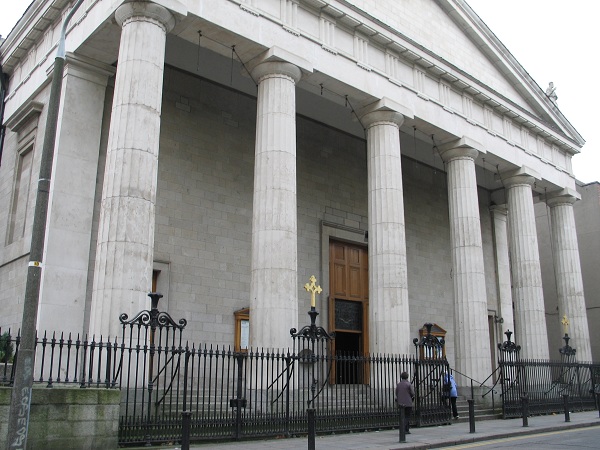
The Pro-Cathedral built in the 1820’s in a severe yet satisfying neoclassical style. it remains only a “Pro-Cathedral” because both of Dublin’s medieval cathedrals ( a unique feature of the city) remain in Anglican hands.
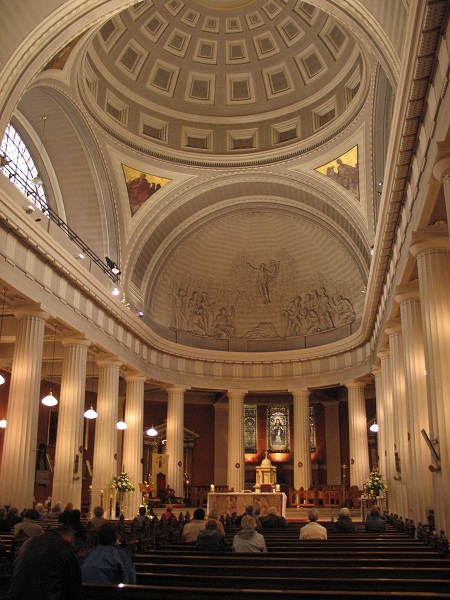
The interior reflects both Roman and Greek (Doric) inspiration.
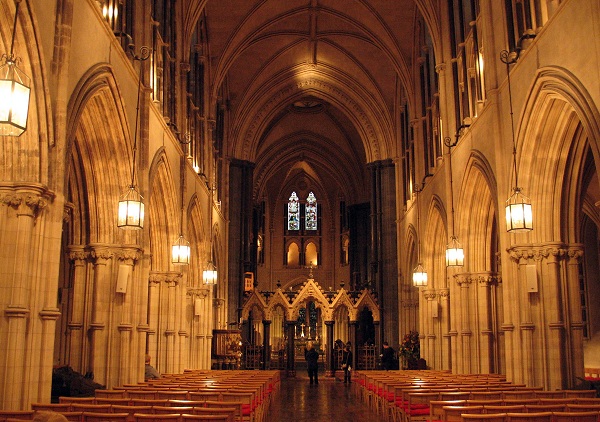
It is somewhat of a relief to turn to the city’s two ancient cathedrals ( I share Pugin’s views on the relative merits of the Gothic and “Classical” styles in church architecture). Dating in large part from the 13th century, they were extensively restored in the 19th. Both St. Patrick’s and Christchurch (shown here) remain in Anglican hands.
24 Aug
2011
Solemn Mass in the Dominican Rite for the Feast of St. Dominic
Posted by Stuart Chessman Published in Masses, PhotosOn Auguust 8th a magnificent Solemn Mass according to the Dominican Rite was celebrated for the Feast of St. Dominic at the Church of the Blessed Sacrament, Seattle. Archbishop J. Peter Sartain of Seattle presided in choro. Reverend Daniel Syverstad, OP, the pastor of Blessed Sacrament Church, was the celebrant. Reverend Christopher Fadok, OP was deacon; Jesson Mata was subdeacon and “Director of Liturgy and Music.” The Tudor choir, under the direction of Doug Fullington, performed Taverner’s Missa Gloria Tibi Trinitas and motets by Arcadelt, Crecquillon, Taverner, Willaert and Sheppard – as well as the propers from the Dominican Gradual.
Need we state that the ceremony and music were magnificent? The large church was completely full for this occasion. There is no question that Blessed Sacrament parish is now becoming a center of the revival of the Dominican Rite. For further splendid photographs of this liturgy and explanations of some of the particular features of the Dominican rite see the website of the subdeacon, Jesson Mata.

The cross facing inward (towards the procession).
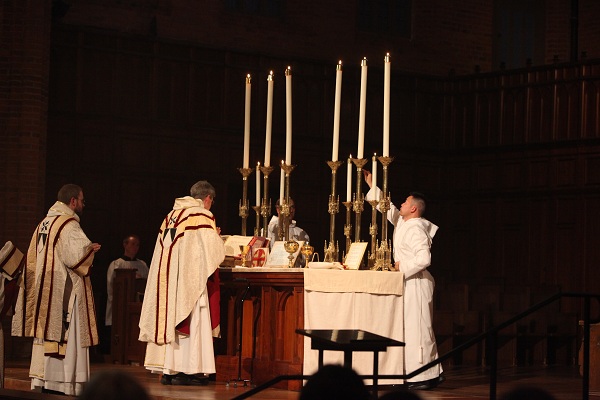
The lighting of candles prior to the consecration.
27 Jul
2011
Return of the Traditional Mass to the Cathedral-Basilica of St. James, Brooklyn
Posted by Stuart Chessman Published in Masses, PhotosAfter 45 years, the Traditional Mass returned on Monday, July 25 to the Cathedral of St. James in Brooklyn. Thanks to the kind invitation of Msgr. John Strynkowski, rector of the Cathedral, and of Bishop Nicholas DiMarzio a splendid liturgy commemorated the patronal feast of the Cathedral. The celebrant was Fr. Richard Cipolla, the deacon, Rev. Mr. Steve Genovese, and the subdeacon Fr. Daniel Champoli of the diocese of Brooklyn. Msgr. Strynkowski preached. David Hughes led the music and Bill Riccio was the master of ceremonies. Needless to say they did their usual outstanding job. A dedicated team of altar servers from St. Mary’s parish, Norwalk, CT came down to assist. I will allow the celebrant, Fr. Cipolla, to describe that evening:
“It was so clear to me on Monday evening, 25 July, how important the Society of St Hugh of Cluny is to the Church at this time. As chaplain of the Society, I offer spiritual support to our members and to our raison d’etre: to actively encourage the celebration of the Extraordinary Form of the Roman rite in the Catholic Church today. On the feast of St James the Apostle, we celebrated Solemn Mass in the Cathedral of St James in Brooklyn. The preacher was the Rector of the Cathedral, Msgr. John Strynkowski. His sermon was a clear and evangelical preaching of the Word. He spoke about the four notes of the Church and the importance of the presence of the Extraordinary Form of the Roman rite as necessary and salutary for the true diversity within unity of the Catholic Church. The music of the Mass, under the direction of David Hughes, was exemplary of the music written for the Traditional Mass: Missa Iste Sanctus by Guerrero, and motets by Victoria and Morales. To be able to celebrate this Mass we packed our cars with altar cards, vestments, candlesticks, all from St Mary’s in Norwalk. One of our MCs, Bill Riccio came with us, and four of our servers. Because of weather and accidents on the road, it took us three and a half hours to get down to Brooklyn from Norwalk, a trip that should have taken just over an hour. Needless to say: it was a real effort on our part.
The Mass was glorious. There were a goodly number of people there. The comments of the people were all positive. I cannot help but be reminded that ours is a missionary effort, to bring wherever we can, the glory of the Traditional Roman rite of the Mass. When we read with open minds and open hearts the Holy Father’s Motu Proprio, Summorum Pontificum, and the recent instruction Universae Ecclesiae, there is no doubt that this Pope believes that the widespread celebration of the Extraordinary Form in the Church today is the antidote to the terrible problems facing the Church. It is not only, in the negative sense, the antidote to the poison of secularism and individualism: it is, in the positive sense, the real presence of the Tradition of the Church that is an inestimable source of grace in these perilous times.
Many thanks to all who make our missionary effort possible. Please consider joining the Society of St Hugh of Cluny and make a worthy contribution to the joyful missionary effort that lies at the very heart of what we are and do.”
St. James is the first Catholic church built on Long Island and the third Catholic church built within the present borders of New York City. For many years it was the “pro-Cathedral” of the Brooklyn Diocese – but no cathedral was eventually built in the wake of the union of the once independent city of Brooklyn with New York City. The diocese of Brooklyn continued, however, and is one of the largest dioceses by population in the United States. The Cathedral owes its present appearance to a rebuilding after a disastrous 1889 fire.
Msgr. Strynkowski preached on the “one, holy, catholic and apostolic Church.”
The Master of Ceremonies, Bill Riccio.
4 Jul
2011
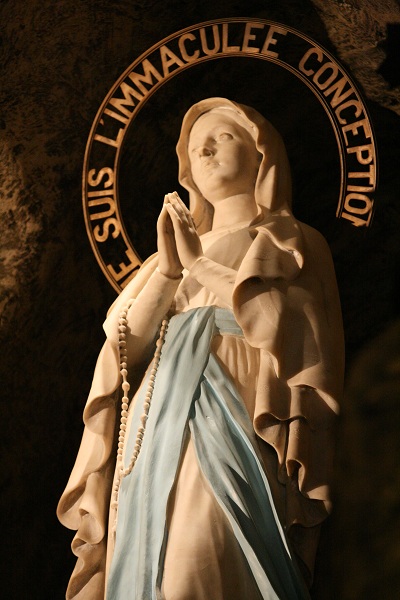
Church of Notre Dame, West 114th Street
By Joris-Karl Huysmans
(Plon, Paris 1908)
It is hard to find a pre-World War II church in Manhattan that does not commemorate in some way the apparition at Lourdes. Sometimes it is a window. More often it is a depiction of the Lourdes grotto itself ranging from small statue groups of Bernadette and the Virgin to life-size recreations. These images give an indication of the impact of Lourdes on Catholic popular piety of that era. And the role of Lourdes in New York was not confined to pictures and statues. In the 1890’s the Redemptorist church of Most Holy Redeemer began dispensing actual Lourdes water – miracles were not slow to follow. Finally, in 1914 New York acquired its own duplicate shrine of Lourdes at the church of Notre Dame on West 114th Street. It functions as an authentic, if little known, “Lourdes in Manhattan” to this very day.
In the early 1900’s Joris-Karl Huysmans (1848-1907) undertook to explore personally the realm of Lourdes. Although the author was by then a Catholic, this book is not at all a conventional exercise in piety. For the spirituality of Lourdes was deeply contrary to the author’s nature. He was a lover of the solitary mystic experience, of the Gothic cathedrals and of the traditional chant of the church. The raucous popular devotion he would encounter at Lourdes was for him a deep challenge.
He encountered armies of pilgrims arriving every day by train from every region of France and beyond. The incessant music – brass bands and popular pilgrimage hymns – was ear-splitting. (Participants in today’s Chartres pilgrimage will recall many hymns that Huysmans specifically mentions: “Laudate Mariam,” “Nous voulons Dieu” etc.). Some of these groups – such as the Bretons – still wore their national costumes. And it is fun to read how Huysmans makes his way into the crowded shrine behind a phalanx of Spanish women wearing mantillas and waving their fans. Many of these pilgrims, of course, were seeking a cure. The author describes their maladies – often cancers or advanced tuberculosis – in almost unendurable detail. The depiction of the stench and the filth, the sweat and the blood can be overpowering.
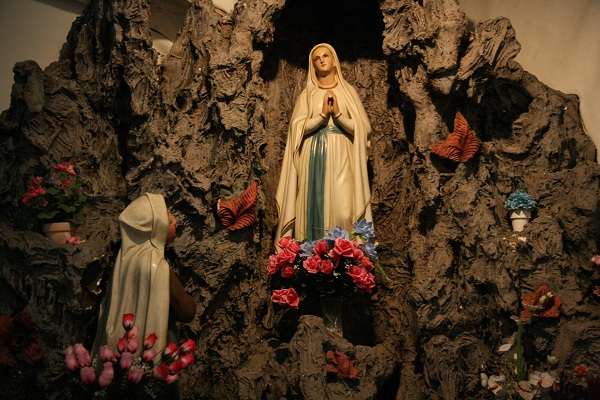
St. John Nepomocene Church, East 66th Street.
Huysmans calls Lourdes the “boiler room” of piety. Everyone seemed to succumb after a while to kind of frenzy. Reports of fresh miracles circulated daily – regardless of whether the official Lourdes bureau accepted them or not. The pilgrim felt cut off from the rest of the world – only Lourdes existed now. Again, it is only on the Chartres pilgrimage that I have felt his same exclusive focus on the immediate, this forgetfulness of the world otherwise so insistent in its demands.
A highlight of this book is the memorable description of the Grotto at night before the arrival of the pilgrimage crowds. It is a veritable sea of light from the thousands of candles. Huysmans explores the symbolism of the candle in these startling terms:
“The candle is composed of three parts; the wax that is the flesh so white of Jesus; the wick that is inserted in that wax which is His most pure Soul hidden under the envelope of his body and the fire which is the emblem of His divinity.”
Elsewhere Huysmans contrasts the ‘living” light of the candle to ‘dead” electric light. And he condemns those who try to deceive God by offering candles not made of beeswax but of poisonous industrial products. In a truly bizarre passage he compares the caretaker of the candles to a gardener tending a bed of different kinds of flowers – which weep waxen tears. By skillfully moving about the candles as they expire, the caretaker enables the various sizes and kinds of candles to mutually support each other – it is an image of the communion of Saints. In this remarkable chapter Huysmans unites precision of observation, esoteric knowledge and the hallucinatory style of his earlier “decadent” novels.
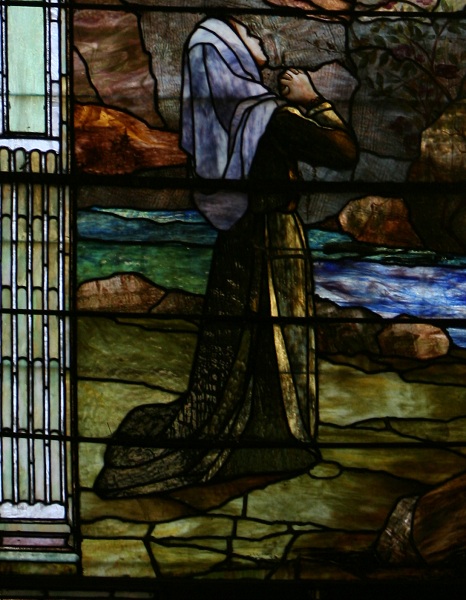
St. Vincent de Paul Church, West 23rd Street.
At times the shock of what he experiences compels Huysmans to abandon the role of the erudite observer and to mingle his prayers with those of the poor and sick. As a procession with the Monstrance circulates among the most severely afflicted pilgrim, the author raises his voice to heaven – Please Lord, help these ones now who have come so far and endured so much! And Huysmans is heartbroken when a young grievously afflicted pilgrim who had appeared cured suffers relapse. How can such a cruel deception happen? Why are so few helped? Yet he already knows the answer to the question, albeit one hard for us to accept. By their prayers and suffering these sick pilgrims are “completing the sufferings of Christ” and in a mysterious way obtaining graces for others or for themselves.
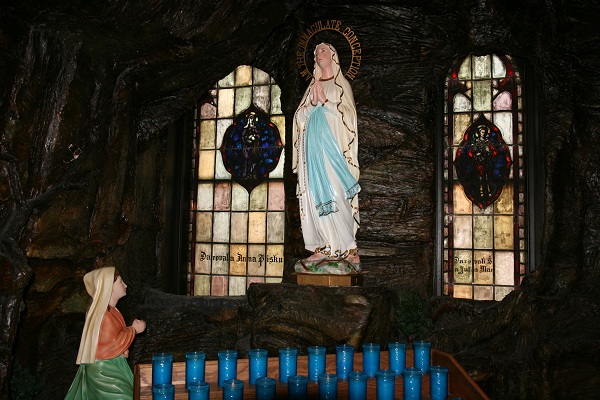
St. Elizabeth of Hungary Church, East 83rd Street
Why review this book now? To recall a monument to a now-vanished world of European popular piety? To inform ourselves about Lourdes from what is even today a treasure trove of the most amazing information about all aspects of the shrine, its history and its operation? Yes – but if we look closely we will see that this work, describing an era situated between the medieval and the modern, also says much about developments we have all lived through in the last half-century.
First, Huysmans a great champion of returning to proper liturgical practice and of plainsong, found little to praise at Lourdes. The liturgical life he experienced at Lourdes was a disaster. The normal form of liturgy was a low mass accompanied by totally unconnected hymns. The hours and office were not sung. Only once did he experience a solemn mass with the appropriate chant – at least for the first half of that service. Huysmans in this book is arguing for a true liturgical reform of a kind that only in our day certain Traditional parishes have partially realized.
Second, Huysmans perceived a distinction in messsage between Lourdes and the immediately preceding apparitions in the Rue du Bac and La Salette. At Lourdes the emphasis is no longer on penance and a warning of disasters to come. Instead, there is the free disbursement of graces, a mission of mercy and clemency. It is obviously a more popular message. Do we not see parallels here with the “non-judgmental” spirituality of the Vatican II Church? (After the author’s death, of course, our Lady at Fatima reiterated the note of warning and the call to repentance of the earlier apparitions.)
But third, and most important, is Huysmans’ meditation on beauty in ecclesiastical art set forth in the extraordinary chapter VI. For Huysmans saw himself totally surrounded by ugliness at Lourdes: the architecture of the churches, the paintings, the music, the attire of most of the pilgrims etc. He had no doubt that this was of satanic origin. For Satan’s chosen weapon against the graces of Lourdes from the very beginning was ugliness. Huysmans explains that art is special gift that may be employed for good or for ill but which always retains its divine character. It is the reproduction of Beauty unique and multiform like the Divinity itself – even though it can only be a feeble mirror of the Infinite Beauty. The beautiful thus has a necessary relation with God (Lamennais). To Huysmans, the contrary is necessarily true -the ugly has a necessary relation with the demon. To depict our Lord in an ugly work art is thus in a sense of work of black magic – transforming divine images into infernal ones. Those are strong words coming from an author who had had much more experience than most men in the occult arts. The ugliness at Lourdes also proceeded from the intrusion of modernity into the Church – this in 1908! The problem of the Church was not that She was behind the times but that She was all too obviously a captive of the taste of the age.
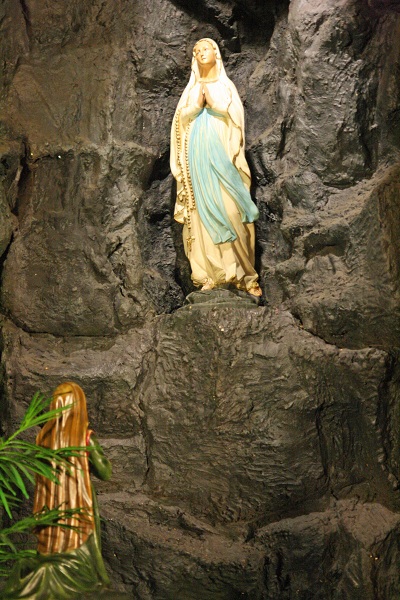
Immaculate Conception Church, East 14th Street.
I cannot imagine the author’s reaction to the contemporary music and art of the Catholic Church. We get a hint of what he would likely think in his condemnation of the intrusion of popular melodies into the liturgy and his savage denunciation of the Rosary basilica at Lourdes because its architecture could just as easly serve as a machine shop or shed for locomotives. A structure, by the way, already bathed in electric light (like St. Patrick’s cathedral in New York today).

St. Cecilia Church, East 105th St.
Although he does not mention it in the text, Huysmans was dying of a very painful form of cancer when he wrote this book, which appeared the year before he died. He had left Lourdes deeply impressed by the unbroken piety of the humbler classes and the charity practiced by the staff of the shrine, the medical personal and certain of the sisters. And once we are forced once again – this time by the author – to compare the pilgrimages to Chartres and Lourdes. For Huysmans states that in 1200 one would have encountered at Chartres the same crowds, the same faith and charity as at Lourdes. Only the architecture, the liturgy and the costumes of the people were of an entirely different order. Now on the pilgrimage to Chartres today the music sung on the march may not be according to the late M. Huysmans’ taste. But he is undoubtedly pleased to see that on every day the solemn mass is celebrated with all its propers sung!

St. Stephen’s Church, East 28th Street.
You can find HERE the original text (this invaluable site has many other texts of Huysmans). An English translation appeared in the 1920’s – it would be well for a publishing house to make this work available to the English-speaking readers again.
3 Jul
2011
Low Mass at the Basilica of St. John the Evangelist in Stamford
Posted by Stuart Chessman Published in PhotosThese photos were taken this morning at the low Mass, which is celebrated every Sunday at 8:30 at the beautiful high altar of the Basilica of St. John the Evangelist in Stamford. The celebrant, substituting for Msgr. DiGiovanni, was Father Cyprian La Pastina, pastor of St. Gabriel Church, Stamford, celebrating the external feast for the Sacred Heart of Jesus.
This Extraordinary Form Low Mass can be viewed live on line every Sunday. Visit the St. Johns parish website at 8:30 am on Sunday: http://stjohnsstamford.com/, and click the photo of the church up top.
24 Jun
2011
Pictures of the Solemn High Mass celebrated at St Gabriel Church in Stamford, CT for the Feast of Corpus Christi. The music for the Mass was Haydn’s Missa Brevis Sancti Joannes de Deo and the Gregorian Propers were sung by a schola of male voices. Following the Mass was an outdoor procession to the Chapel of St. Philip Neri followed by Benediction after returning to the church.
Pictures forwarded by Fr. Cyprian LaPastina.
24 May
2011
Solemn Pontifical Mass of the St. Gregory Society
Posted by Stuart Chessman Published in Masses, PhotosCompleting our coverage of the Traditional services celebrated on Sunday, May 15, we are pleased to show pictures from the 25th Anniversary Jubilee Mass of the Saint Gregory Society, at Saint Stanislaus Church, New Haven. The Solemn Pontifical Mass in honor of Saint Gregory the Great was celebrated by the Most Reverend James C. Timlin, Bishop Emeritus of Scranton, PA.
Pictures courtesy of Douglas Turecek; more pictures of this event at his site.
Contact us
Register
- Registration is easy: send an e-mail to contact@sthughofcluny.org.
In addition to your e-mail address, you
may include your mailing addresss
and telephone number. We will add you
to the Society's contact list.
Search
Categories
- 2011 Conference on Summorum Pontifcum (5)
- Book Reviews (95)
- Catholic Traditionalism in the United States (24)
- Chartres pIlgrimage (17)
- Essays (176)
- Events (670)
- Film Review (7)
- Making all Things New (44)
- Martin Mosebach (34)
- Masses (1,343)
- Mr. Screwtape (46)
- Obituaries (15)
- On the Trail of the Holy Roman Empire (22)
- Photos (347)
- Pilgrimage Summorum Pontificum 2021 (7)
- Pilgrimage Summorum Pontificum 2022 (6)
- Pilgrimage Summorum Pontificum 2023 (4)
- Sermons (79)
- St. Mary's Holy Week 2019 (10)
- St. Mary's Holy Week 2022 (7)
- St. Mary's Holy Week 2023 (7)
- St. Mary's Holy Week 2024 (6)
- Summorum Pontificum Pilgrimage 2024 (2)
- The Churches of New York (198)
- Traditionis Custodes (49)
- Uncategorized (1,369)
- Website Highlights (15)
Churches of New York
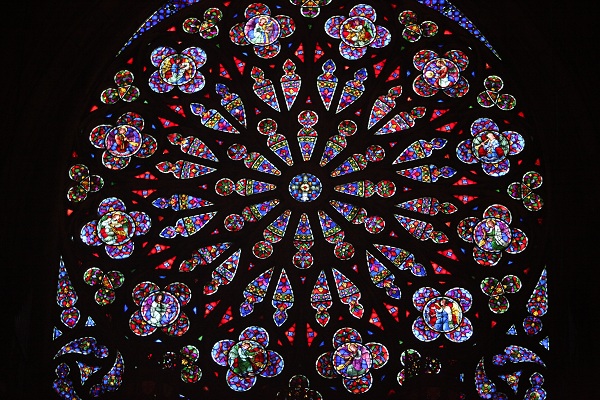
Holy Roman Empire
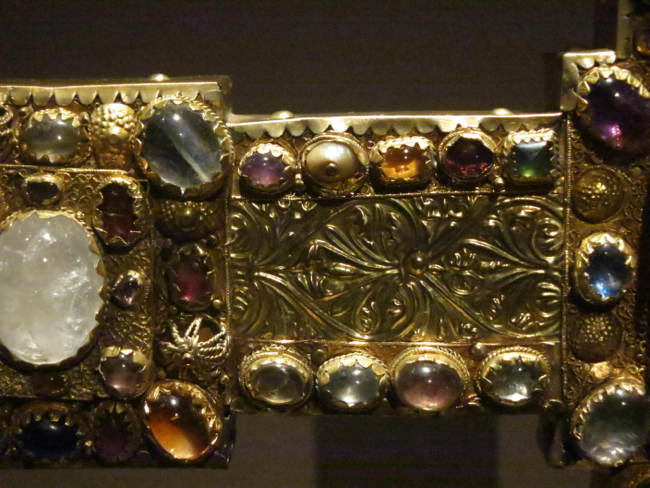
Website Highlights
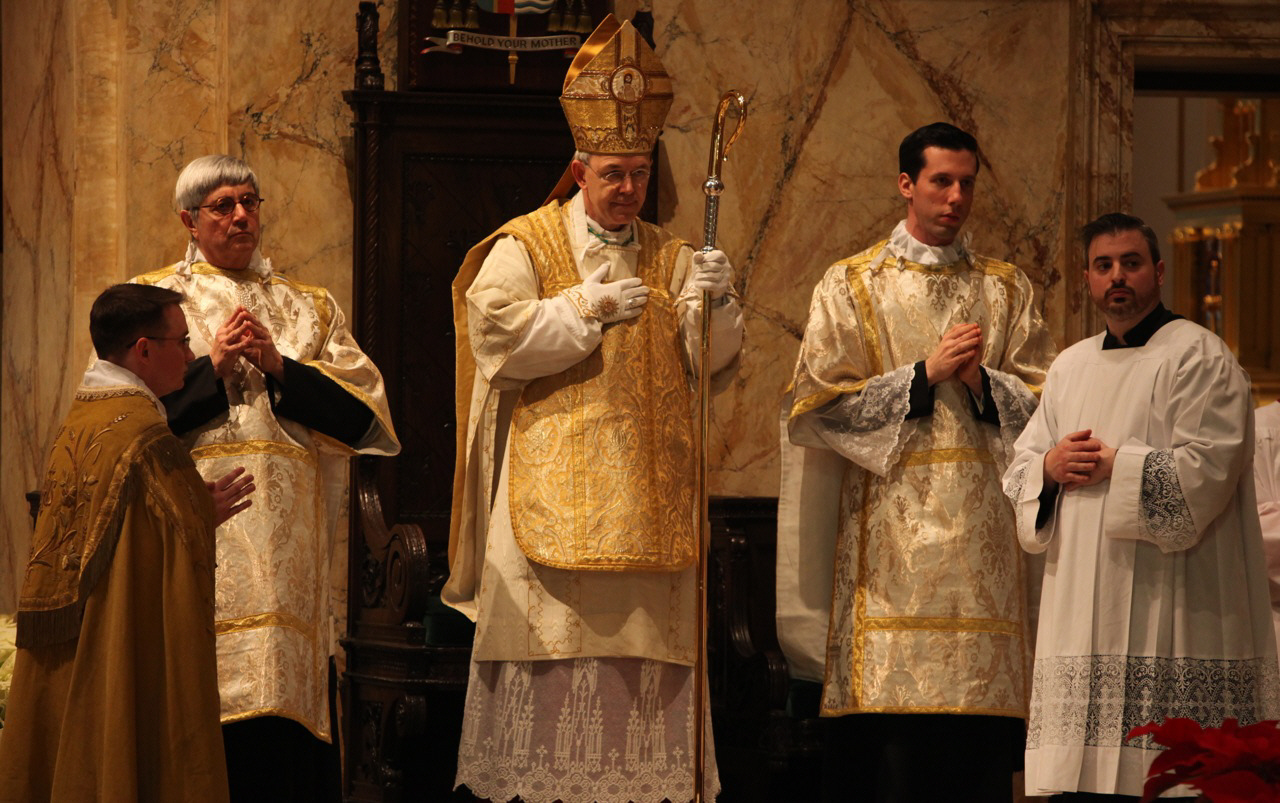
Archives
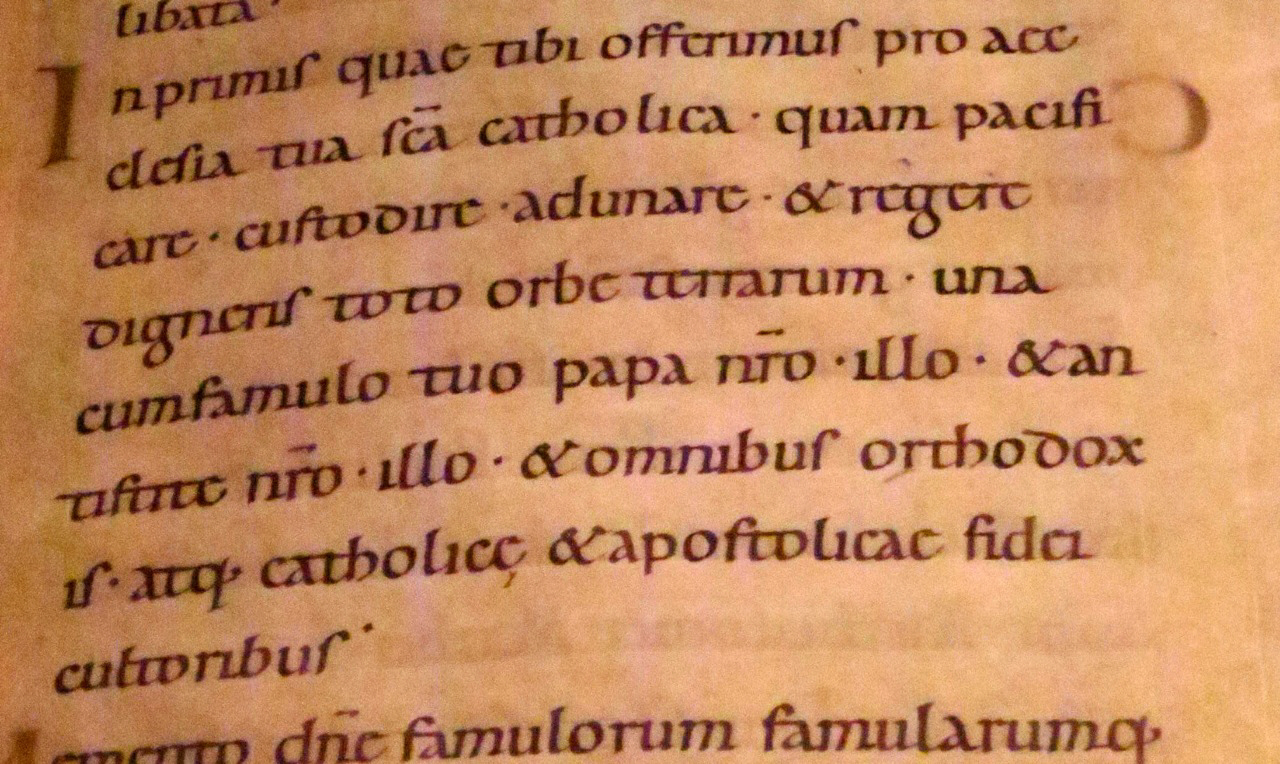
[powr-hit-counter label="2775648"]
